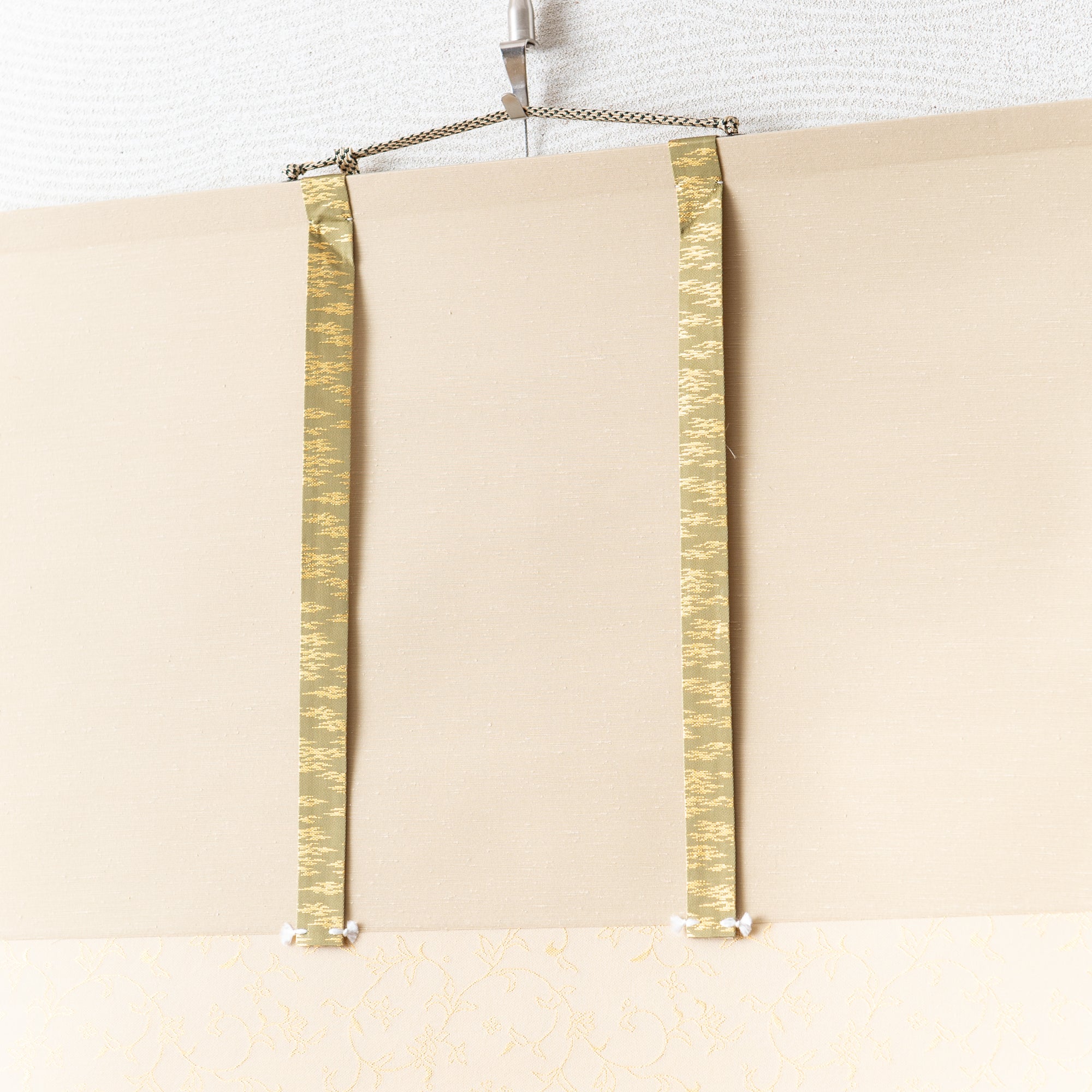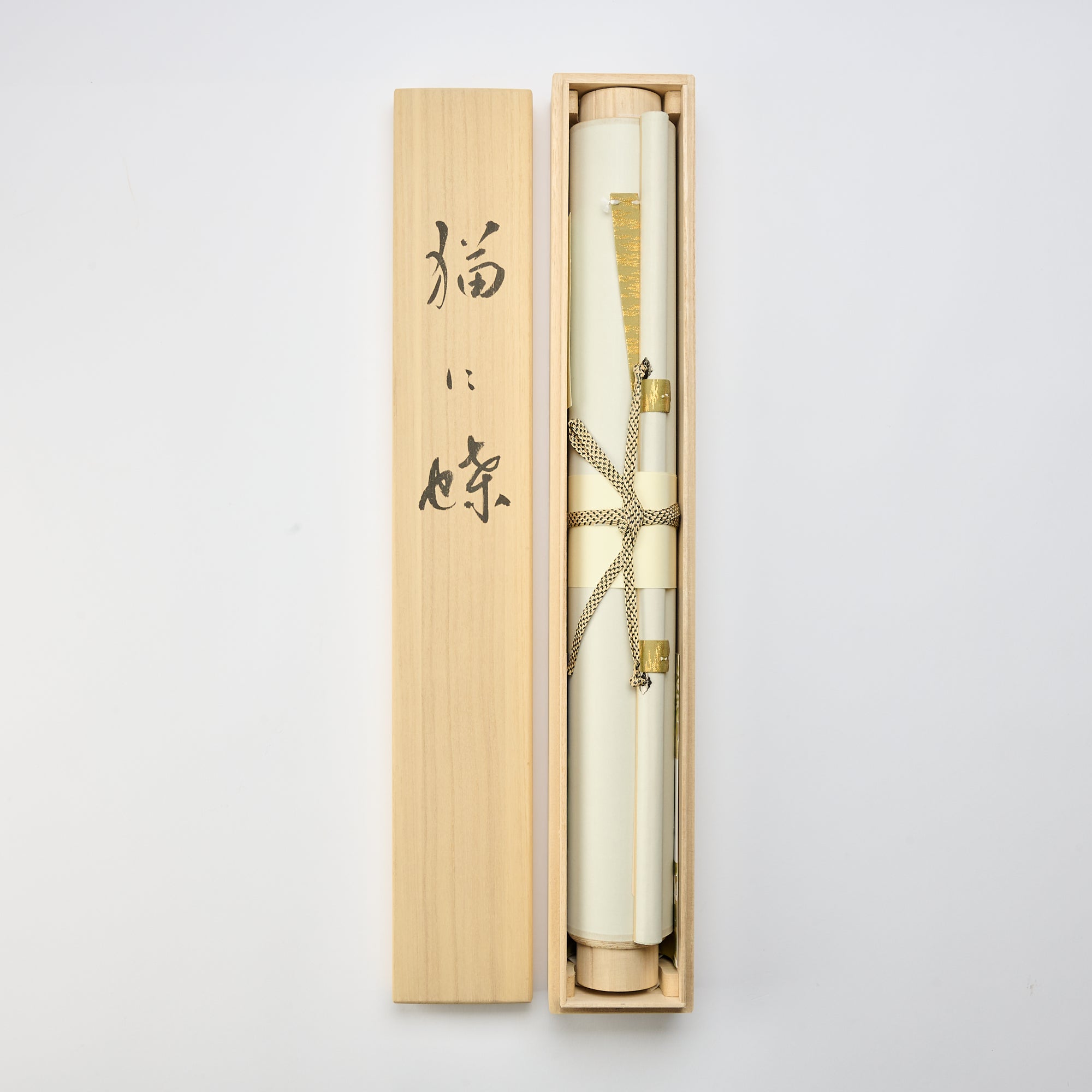




















Cat and Butterfly / Kakejiku Hanging Scroll
The subject of the hanging scroll is “Cat and Butterfly.”
The combination of a cat and a butterfly is one of the auspicious paintings. From a distance, it appears as if a cat in the sunlight is conversing with a butterfly, enveloped in a serene atmosphere. In fact, the combination symbolizes longevity in Chinese; the sound of “cat” in Chinese (耄) suggests 70 years old, and sound of “butterfly” (耋) in Chinese represents 80 years old.
In Japan, butterflies have long been a symbol of rebirth and immortality, due to their transformation from chrysalises. During the samurai era, it was so popular as a family crest.
Focusing on the cat, it is a traditional calico. The maneki neko “lucky cat” known to bring good fortune, is also said to be a calico.
White signifies “inviting happiness and fortune,” black represents “warding off evil and misfortune,” and the bright brown is likened to the vermillion of Shinto shrine torii gates, symbolizing “freedom from illness and misfortune.”
When first unrolling the scroll, one initially sees a flesh-colored cotton damask kireji cloth, followed by a dazzling gold brocade with arabesque patterns in the chuberi "central border fabric".
In the ichimonji section, the Rikyu Kasumi pattern draws the eye.
The beautiful gradient woven by gold and green is stunning even from a distance, making the arabesque patterns appear as if they are floating. The arabesque pattern, with its sprawling stems, leaves, and vines, symbolizes vitality and hence represents "longevity" and "prosperity."
This product, "Cat and Butterfly," is carefully stored, wrapped around a scroll rod, inside a beautiful wooden paulownia box. The cylindrical parts at both ends of the scroll, known as jikusaki, are crucial when storing the scroll. The jikusaki of this product are made of stoneware, and the material used for the scroll ends can be indicative of who created it and for what purpose, adding to its allure.
The hanging scroll is an important item that allows one to enjoy various events and seasonal changes, bringing a sense of ease and the transition of the seasons into everyday life. It is also frequently used to entertain guests who visit.
Tracing its history, the hanging scroll was introduced to Japan during the Asuka period (538 CE–710 CE). It coincided with the arrival of Buddhism from China, and initially, Buddhist paintings were depicted on these scrolls. In the Heian period(794 CE–1185 CE), these Buddhist painting scrolls became popular among the aristocracy. By the late Kamakura period(1185 CE–1333 CE), with the popularity of the tea ceremony, alcoves were created to display power.
In the Azuchi-Momoyama period(1568 CE–1600 CE), influenced by the tea master Sen no Rikyu, scrolls began to be changed seasonally. The mounted scroll, appreciated in these alcoves, plays an important role in Japanese interior decoration.
Hanging scrolls are deeply rooted in Japanese traditional culture, yet the number of Japanese rooms and alcoves where scrolls are displayed has been decreasing. However, the value of conveying the messages encapsulated in scrolls remains undeniable.
The charm of these scrolls lies in the different meanings expressed by the characters and paintings they depict, the fabrics used in the details, and the patterns.
Today, they add color to both homes and offices and are ideal for collections of Japanese art. Hanging scrolls not only represent Japanese culture but also provide viewers with a sense of richness and a serene space.
| Quantity | |
| Size | |
| Weight | |
| Material | |
| Package type | Paulownia box |
| Origin | Made in Japan |
| Artist / Brand |
Choose options






















This auspicious cat and butterfly, portrayed in the elegant touch of Suzuki Sensei, exude tranquility.
The softness of the silk painting used for the main work likely adds to the effect.
Eginu "silk painting" refers to a special type of silk fabric used for painting or calligraphy.

It is a plain weave, thin silk fabric with a rough texture and stiffness, resulting from the threads drawn from silk cocoons and softly woven into the fabric. Its whiteness and subtle shimmer, along with its soft texture, enhance the beauty of the artwork.
This scroll, with its design suitable for various spaces, including Japanese-style rooms, adds a festive touch to the ambiance of a room.
About Craftsmen
Suzuki Yuri
Born in 1958 in Gifu Prefecture. Specializing in bird-and-flower paintings, classical designs, figurative, and animal paintings, she has won numerous awards including being selected for the 5th Maeda Seison Memorial Grand Prize. Currently a member of the Bokusai-kai.
Her works are featured in the art yearbook.
Renowned for its delicate style of painting, she is energetically engaged in creative activities, surrounded by the rich nature of Gifu Prefecture.

